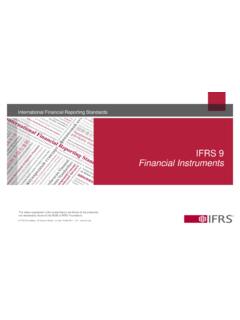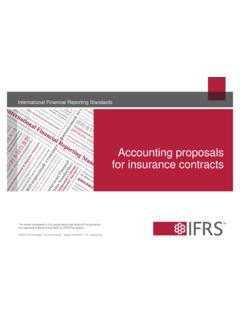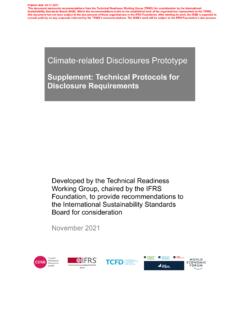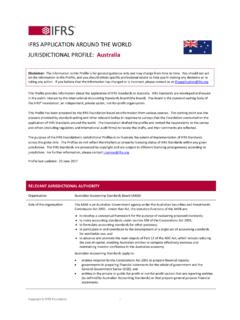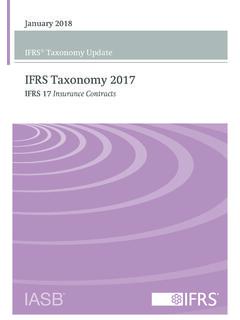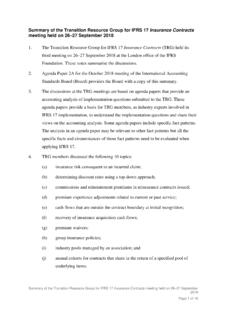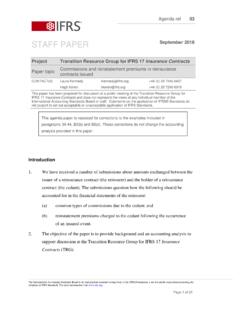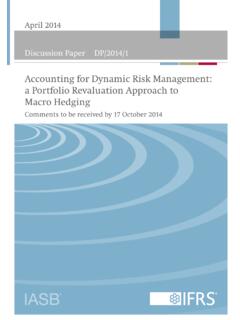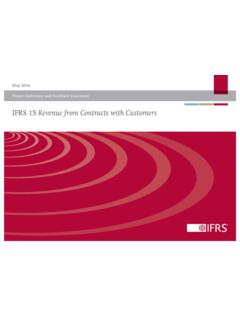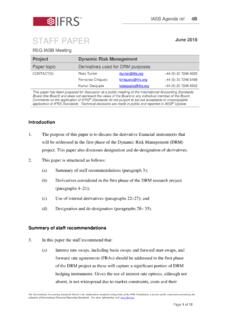Transcription of IFRS 17 Insurance Contracts
1 May 2017. ifrs Standards Effects Analysis ifrs 17 Insurance Contracts This Effects Analysis accompanies, but is not part of, ifrs 17. What is the purpose of this Effects Analysis? This Effects Analysis describes the likely costs and benefits of ifrs 17. The costs and benefits are collectively referred to as effects'. The International Accounting Standards Board (the Board) gains insight into the likely effects of new or revised ifrs Standards through its exposure of proposals to stakeholders and through its analysis and consultation with them. This document describes the Board's considerations of the effects of ifrs 17. Background The Board decided to proceed in two phases in establishing the accounting for Insurance Contracts : Phase 1 completed in 2004 by issuing ifrs 4 Insurance Contracts focused on enhanced disclosure of the amount, timing and uncertainty of future cash flows from Insurance Contracts .
2 ifrs 4 allows Insurance companies1 to continue to use various accounting practices, pending a fundamental reassessment of the accounting for Insurance Contracts . Phase 2 completed in 2017 by issuing ifrs 17 focused on the measurement and presentation of Insurance Contracts and the development of a comprehensive ifrs Standard for Insurance Contracts . ifrs 17 supersedes ifrs 4 and completes the Board's project to establish a specific ifrs model for the accounting for Insurance Contracts . ifrs 17 is effective from 1 January 2021. A company can choose to apply ifrs 17 before that date but only if it also applies ifrs 9 Financial Instruments and ifrs 15 Revenue from Contracts with Customers.
3 Glossary Many terms used in this document are specific to Insurance . See the glossary on pages 134 138 for definitions of those terms. 1 I n this document, the term company' refers to an entity that prepares financial statements using ifrs Standards. The term insurer' or Insurance company' refers to an entity that issues Insurance Contracts as defined in ifrs 17. 2 | Effects Analysis | ifrs 17 Insurance Contracts | May 2017. The need for ifrs 17. The Insurance industry fulfils a central role in the The nature of their business exposes insurers and The new Standard will result in a significant increase global economy. Insurance companies enable people investors in insurers to many risks.
4 The financial in global comparability and enhance the quality of and companies to transfer risks. Moreover, insurers, health of insurers affects the global economy because financial information. like other institutional investors, are important long- of policyholders' and investors' exposure to insurers The timely information ifrs 17 requires will be term investors. With US$13 trillion in assets, insurers and insurers' role as institutional investors. This is beneficial for capital markets because it will boost account for 12 per cent of the total assets of listed why the financial statements of insurers need to reflect investors' understanding of insurers' expected future companies that use ifrs Given the central Insurance risks, and changes in those risks, in a timely profitability, risks and changes in Insurance obligations.
5 Economic role of the industry, proper accounting for and transparent way. This should make the Insurance industry more Insurance Contracts is of crucial importance. Better reflecting economic reality, attractive to investors, facilitating improved capital allocation. improving comparability Improved transparency resulting from ifrs 17 is also US$28 Non-financial The existing Standard, ifrs 4, allows insurers to account expected to contribute to long-term financial stability by companies differently for Insurance Contracts they issue, even if revealing useful information that will enable actions to 25% those Contracts are similar.
6 Further, many insurers'. be taken in a timely way. financial statements lack regular updates of the value of US$110. Insurance obligations to reflect the effect of changes in trillion of Insurance ifrs 17 is the first comprehensive and truly the economic environment, such as changes in interest total assets US$13 companies rates and risks. international ifrs Standard establishing 12% the accounting for Insurance Contracts ifrs 17 addresses many inadequacies in the existing wide range of Insurance accounting practices. It issued by a company. It replaces ifrs 4 an Other financial US$69 companies requires all insurers to reflect the effect of economic interim Standard.
7 ifrs 4 does not prescribe 63% changes in their financial statements in a timely the measurement of Insurance Contracts and transparent way. It will also provide improved and instead allows companies to use local information about the current and future profitability accounting requirements (national GAAP), of insurers. or variations of those requirements, for the measurement of their Insurance Contracts issued. 2 Data based on the latest annual financial information available in the Capital IQ database for listed companies using ifrs Standards at the date of issue of ifrs 17 ie 2015 annual reports for the majority of companies.
8 Effects Analysis | ifrs 17 Insurance Contracts | May 2017 | 3. Executive Summary ifrs 17 sets out the requirements that a company ifrs 17 requires the company to update the fulfilment Why ifrs 17 has been developed should apply in reporting information about Insurance cash flows at each reporting date, using current Contracts it issues and reinsurance Contracts it holds. estimates of the amount, timing and uncertainty of ifrs 4 does not address how to measure Insurance cash flows and of discount rates. Contracts . Insurers currently use a wide range of Requirements of ifrs 17 Insurance accounting practices for reporting on a key The company: ifrs 17 requires a company that issues Insurance aspect of their business.
9 Differences in accounting Contracts to report them on the balance sheet as the (a) accounts for changes to estimates of future cash treatment across jurisdictions and products make total of: flows from one reporting date to another either as it difficult for investors and analysts to understand an amount in profit or loss or as an adjustment to and compare insurers' results. Most stakeholders, (a) the fulfilment cash flows the current estimates of the expected profit for providing Insurance coverage, including insurers, agree on the need for a common amounts that the company expects to collect from depending on the type of change and the reason global Insurance accounting standard even though premiums and pay out for claims, benefits and for it; and opinions vary as to what it should be.
10 Insurance expenses, including an adjustment for the timing (b) chooses where to present the effects of some changes Contracts often cover difficult to measure long term and risk of those amounts; and in discount rates either in profit or loss or in other and complex risks. Insurance Contracts are not (b) the contractual service margin the expected profit typically traded in markets and may include a comprehensive income. for providing Insurance coverage. significant deposit component, posing further ifrs 17 also requires disclosures to enable users of measurement challenges. Some existing Insurance The expected profit for providing Insurance coverage is financial statements to understand the amounts accounting practices fail to reflect adequately the true recognised in profit or loss over time as the Insurance recognised in the company's balance sheet and underlying financial positions or performance arising coverage is provided.
